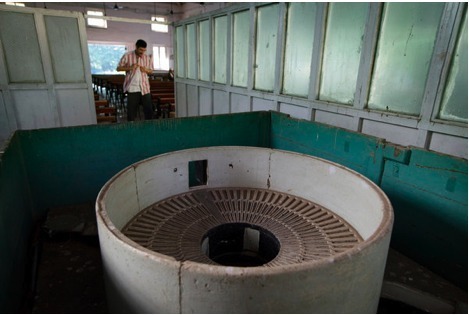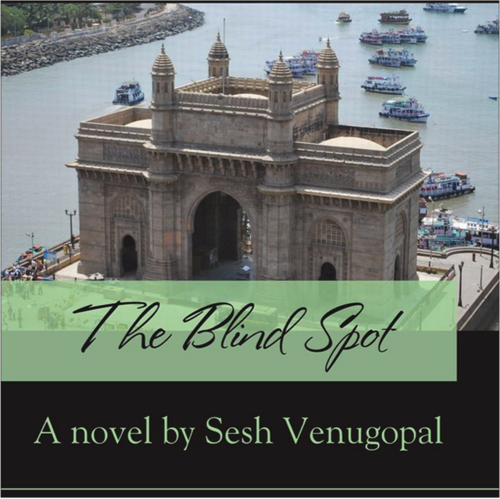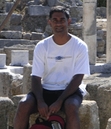Sesh Venugopal's Blog
April 10, 2013
I will be at the Local Author Day at the Princeton public...
February 13, 2013
"The Blind Spot" - Book reading on Feb 20
At the Edison public library, North Edison branch, NJ. Details.
Book Reading - Jan 29, 2013
A reading from my novel, “The...
Book Reading - Jan 29, 2013
A reading from my novel, “The Blind Spot”, at the Highland Park public library, NJ. Jan 29 In this scene, Sam reveals to his father, Kris, that he has lost his job. “The Blind Spot” is available at amazon.com. See http://www.seshblindspot.com for more details.
Book Reading - Jan 29, 2013
A reading from my novel, “The...
Book Reading - Jan 29, 2013
A reading from my novel, “The Blind Spot”, at the Highland Park public library, NJ. Jan 29 In this scene, Carl lies in wait for Sam at the Elephanta Caves in Mumbai. “The Blind Spot” is available at amazon.com. See http://www.seshblindspot.com for more details.
Book Reading - Jan 29, 2013
A reading from my novel, “The...
Book Reading - Jan 29, 2013
A reading from my novel, “The Blind Spot”, at the Highland Park public library, NJ. Jan 29. Having fled Bombay for America, Krishna finds himself in no-man’s land of identity: between the Krishna of old, and a new work-in-progress “Kris”. “The Blind Spot” is available at amazon.com. See http://www.seshblindspot.com for more details.
Book Reading - Jan 29, 2013
A reading from my novel, “The...
Book Reading - Jan 29, 2013
A reading from my novel, “The Blind Spot”, at the Highland Park public library, NJ. Jan 29 This passage describes Nancy’s state of mind as she deals with the consequence of a shattered romance. “The Blind Spot” is available at amazon.com. See http://www.seshblindspot.com for more details.
January 3, 2013
Who Needs a New Language?
A former DMV employee in California developed a new language that he called Ithkuil. He had spent three decades on it! In 2004 he posted the entire nine yards on the web: “Ithkuil: A Philosophical Design for a Hypothetical Language”, detailing the grammar, syntax and lexicon of Ithkuil. I came across this strangely intriguing development in an article that appeared in the New Yorker in December 24/31 issue, written by Joshua Foer.
The first thought that popped into my head was: “Does the world need a new language?” There are thousands of them already in existence. What’s the point? Then I thought of movies and TV shows in which the characters break into tongues. “Lord of the Rings” comes to mind. I learned that Tolkien had invented this language that he wanted to try out, and he pretty much wrote the Lord of the Rings books just to get the word out! And there’s Star Trek with Klingon. And the Game of Thrones with Dothraki.
While I admire the ingeniousness (bloody mindedness?) of the creators of these languages, I always felt it was pretentious. Languages constructed from scratch as in a laboratory might have logical completeness and soundness, but they come across as sterile. And no real person wants to speak them. Just think of the “global” language Esperanto.
Growing up in India, I spoke four languages: English (the medium of instruction in school), Hindi (compulsory second language), Marathi (language of the state of Maharashtra to which Bombay belongs), and Tamil (“mother-tongue” of my parents). I enjoyed the diversity, and each language bespoke a different culture, a different way of seeing the world, a different sensibility to life. Later in life, I picked up Turkish. Yet I have barely scratched the surface. If you really must throw in some made up language into an American movie or TV show, why not use one of the more arcane of the thousands of languages spoken by real people in the real world? It will be as equally foreign to the average watcher, and much less expensive to produce.
December 2, 2012
This is one of the “Towers of Silence", in Mumbai, India,...

This is one of the “Towers of Silence", in Mumbai, India, in which Parsis (Zoroastrians, descended from ancestors who fled Iran in the 10th century and settled in Bombay) place bodies for disposal by vultures. This photo is taken from an article that appeared in the New York Times yesterday, about the problems Parsis are having because the population of vultures is dwindling to the point where there aren’t enough of them to consume the bodies. This is forcing the Parsis to turn to cremation, which violates their beliefs. Click on the photo to read the fascinating story.
In my novel, "The Blind Spot", I have this conversation between two characters, one an Indian who has moved from his native Delhi to Mumbai, and another, an Indian-American, who has recently relocated to Mumbai, both working at the same company.
——————————————————————————————
A few yards down the road, we came upon a biscuit-colored entrance archway that must have been a good five storys high, presaging what appeared to be a large compound of buildings and lush foliage. The black gates were thrown open.
"Cusrow Baug,” I said aloud, reading the sign above the arch. “Buildings for Parsees.” I turned to Rajiv. “Who are Parsees?"
"Persians—Zoroastrians—who fled Iran to escape Muslim persecution, and landed in Bombay.” He was gazing at the arch, wearing a distant look. “Hundreds of years ago.”
"They have their own exclusive neighborhoods, like gated communities?”
He turned to me. “There a few. This one is the most well known. There aren’t too many of them, so they like to stick together. Also, they very rarely marry outside their community. We call them bawas.”
"Why?”
"No idea.” He shrugged. “It’s this thing, like gujju, for Gujaratis, or madrasi, for anyone who is from south India. Of course those terms have obvious origins, but…” He paused, brows furrowed. Then added, “I don’t think bawa is used outside of Bombay. To be honest, I am not sure people outside of Bombay even know of Parsees.”
This piqued my curiosity. I had never heard of Parsees before this, and Rajiv seemed more than willing to indulge me. As a matter of fact, all this talk of Parsees seemed to have lit a spark in him.
"Tell me more,” I said, as we resumed walking up the Causeway.
His face lit up. “Ah, I see you are getting into it. Ok, a couple of remarkable Parsee facts that every Bombayite knows. First: they pray at what are called fire temples. The unusual thing is that the temple is actually a well, with a fire burning inside.”
He must sensed some disbelief in my reaction. “There’s one in Churchgate,” he said quickly. “I’ll show you on our way back.”
"All right, fact one filed away. And the other thing?”
"Oh yes, the second one is… even more remarkable. Parsees don’t bury their dead.”
I wasn’t sure why this was a big deal. “So they cremate them?”
He shook his head. I raised my eyebrows.
"They leave the body out, to be picked clean by scavenging birds.”
Now he had be spellbound. “Really?”
He nodded. “There’s this place called the Tower of Silence in Malabar Hill, not too far from here, where they put out the bodies. A kind of clearing in the woods, high above the city. You can’t see it from the outside, it’s pretty well hidden. Only Parsees are allowed in, of course.”
This is one of the “Towers of Silence”, in Mumbai,...

This is one of the “Towers of Silence”, in Mumbai, India, in which Parsis (Zoroastrians, descended from ancestors who fled Iran in the 10th century and settled in Bombay) place bodies for disposal by vultures. This photo is taken from an article that appeared in the New York Times yesterday, about the problems Parsis are having because the population of vultures is dwindling to the point where there aren’t enough of them to consume the bodies. This is forcing the Parsis to turn to cremation, which violates their beliefs. Click on the photo to read the fascinating story.
In my novel, “The Blind Spot”, I have this conversation between two characters, one an Indian who has moved from his native Delhi to Mumbai, and another, an Indian-American, who has recently relocated to Mumbai, both working at the same company.
——————————————————————————————
A few yards down the road, we came upon a biscuit-colored entrance archway that must have been a good five storys high, presaging what appeared to be a large compound of buildings and lush foliage. The black gates were thrown open.
“Cusrow Baug,” I said aloud, reading the sign above the arch. “Buildings for Parsees.” I turned to Rajiv. “Who are Parsees?”
“Persians—Zoroastrians—who fled Iran to escape Muslim persecution, and landed in Bombay.” He was gazing at the arch, wearing a distant look. “Hundreds of years ago.”
“They have their own exclusive neighborhoods, like gated communities?”
He turned to me. “There a few. This one is the most well known. There aren’t too many of them, so they like to stick together. Also, they very rarely marry outside their community. We call them bawas.”
“Why?”
“No idea.” He shrugged. “It’s this thing, like gujju, for Gujaratis, or madrasi, for anyone who is from south India. Of course those terms have obvious origins, but…” He paused, brows furrowed. Then added, “I don’t think bawa is used outside of Bombay. To be honest, I am not sure people outside of Bombay even know of Parsees.”
This piqued my curiosity. I had never heard of Parsees before this, and Rajiv seemed more than willing to indulge me. As a matter of fact, all this talk of Parsees seemed to have lit a spark in him.
“Tell me more,” I said, as we resumed walking up the Causeway.
His face lit up. “Ah, I see you are getting into it. Ok, a couple of remarkable Parsee facts that every Bombayite knows. First: they pray at what are called fire temples. The unusual thing is that the temple is actually a well, with a fire burning inside.”
He must sensed some disbelief in my reaction. “There’s one in Churchgate,” he said quickly. “I’ll show you on our way back.”
“All right, fact one filed away. And the other thing?”
“Oh yes, the second one is… even more remarkable. Parsees don’t bury their dead.”
I wasn’t sure why this was a big deal. “So they cremate them?”
He shook his head. I raised my eyebrows.
“They leave the body out, to be picked clean by scavenging birds.”
Now he had be spellbound. “Really?”
He nodded. “There’s this place called the Tower of Silence in Malabar Hill, not too far from here, where they put out the bodies. A kind of clearing in the woods, high above the city. You can’t see it from the outside, it’s pretty well hidden. Only Parsees are allowed in, of course.”
November 25, 2012
London Calling
Away in London during Thanksgiving, there was no hint of the most celebrated holiday in the US. No Turkey dinner! No family get together! Not even a holiday! People went about their business as usual. No black Friday! It was a gentle reminder that this is a world in which we, the billions, care about a vast number of things, many of which are not common with most others on the planet.
Hanging about in London was a lesson in stepping out of one’s small universe of friends, acquaintances, and comforting routines and experience how others live, what they care about, what they believe in, and how odd it is that while we are similar in many respects, we couldn’t be more different in many others.
It struck me that even in the much smaller world in which we live, the connecting forces of the internet haven’t really bridged so many of the differences between us. Beliefs and traditions balk at crossing geographical boundaries. Which is why even in this much smaller world, London is as separate and distinct from New York as it ever was. We may know a lot more about what our fellow humans in Siberia may be up to, but that doesn’t mean we understand why.




